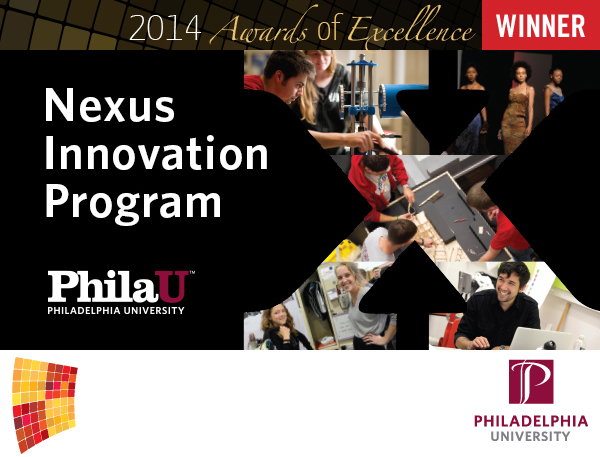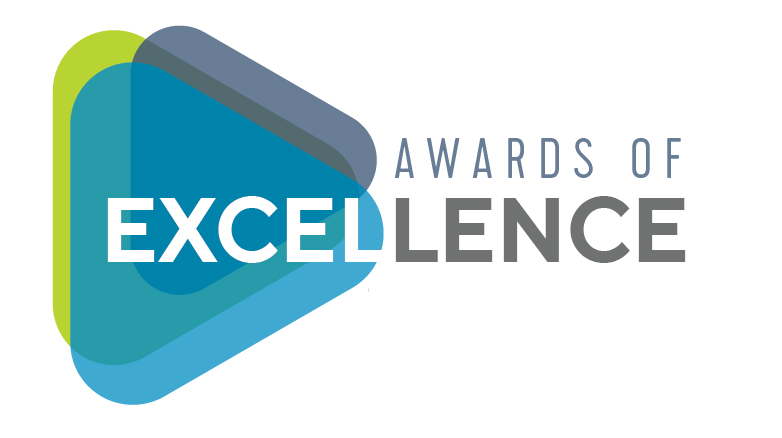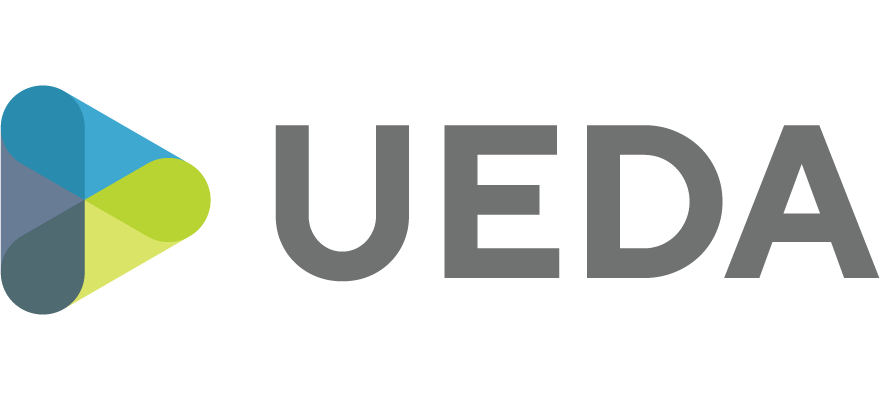Network

| Award Category: | Innovation and Entrepreneurship |
| Project Site: | Nexus Innovation Program |
| Submitted By: | Philadelphia University |
| Contact: | D. R. Widder , 215.951.2766 |
Case Study
Abstract
Philadelphia University’s Kanbar College created a new curriculum around innovation, to bring innovation to industry in the region and beyond. To accomplish this, we fully integrated the school of design, school of engineering, and business school into an integrated curriculum, figuratively and literally under one roof.
The Nexus Innovation Program brings the innovation processes out of the classroom and applies them directly to companies.
Companies such as Unilever, Newell Rubbermaid, Armstrong, and Federal Mogul have sponsored projects that have led to new ideas and commercial product opportunities
What makes the program unique and successful is that it is transdisciplinary – teams are comprised of students from different majors and year, that it is real world – the problems addressed are not homogenized, they are complex and a real context of a company’s technology, business, and team, and they are active – students interact as professionals directly with company staff and subject matter experts. Also, the program is based on the combined goal of achieving strong educational outcomes and real business impact. In this way, the University becomes an extension of the company’s innovation resources, and the companies become partners in education. Projects are a combination of high energy sprints, designed to produce a volume of concepts over the course of a single week, and deep dies, designed to full develop a concept from a design, engineering prototype, and business model standpoint. This program has gained significant traction in both academic and industrial realms.
Problem/Background
Philadelphia University was founded in 1884 to train future leaders for industry. It has continually evolved based on closely working with and understanding the changing needs of industry to develop talent with the skills needed to support high grown businesses.
Industry leaders frequently cite the gaps between entry level college graduates skills, and what they need to succeed. This includes employees that can collaborate across disciplines, communicate across organizations, and who can pivot into new situations and conditions. T-shaped thinkers are needed, with the depth of their own discipline, combined with the breadth of perspective to work with both the practitioners and frameworks of a large set of disciplines.
Real world problems, and real work opportunities, do not fit in the silos of specific disciplines. The rapid pace of change has shifted the value of education to be less dependent on knowledge of facts, and more dependent on integrated skills including collaboration, creativity, interdisciplinary understanding, and the ability to communicate to team members with diverse backgrounds.
In parallel, students need more real world experience ways to distinguish themselves in the increasingly competitive job market. A tough economy – – recent attention to the difficulty in finding jobs in their field, coupled with the high cost in education – has made students statistically more focused on the direct connection between their education experience and job placement.
Solution
This need drove us to reconfigure our organizational structure and create the curricula of different disciplines together at an unprecedented level of integration. This includes combining design, engineering, and business programs into a common core. All of these disciplines take a core DEC track in addition to their discipline’s normal subject matter. This DEC core has five elements
- Integrated Design Processes – Drawn heavily from the design disciplines – problem finding, team forming, and iteration.
- Business Models – Drawn from business disciplines – stakeholder analysis, business model structure, and financial components
- Systems – Drawn from engineering disciplines – understanding systems thinking, dynamics, complexity, and sustainability
- Research Methods – Ethnography, market analysis, biomimicry.
- Capstone – Senior project tying the core together, project based, industry sponsored projects.
Students from all the disciplines take these together. The core is heavily project based, and starts freshman year, so students are learning collaboration, teaming, and communication skills from the beginning.
The key innovations of our program include:
- Multidisciplinary – No projects are undertaken where the problem and solution are one dimensional within a single discipline
- Team Diversity – Designers, Engineers, Architects, Sustainability majors, business majors, occupational therapy students, etc. working in a collaborative teams. Teams may include a combination of Juniors, Seniors, graduate students, and sometimes sophomores and freshman.
- Transdisciplinary – All students are expected to understand all aspects of the project, not just their discipline. Often they will present in a crossover fashion, with the design student presenting engineering elements, business students presenting design elements, and engineering students presenting financial analysis
- Students as Professionals –Students interact directly with the companies; they are not buffered from the real world aspects. Also there are high expectations for professional results the company can use.
- Business Impact – Complicated problems of high priority and interest to sponsors, with constraints such as company strategy and sales channels, manufacturing capabilities, team dynamics, and financial viewpoints
Results
The Nexus Innovation program is entering its third year, this program has benefited many dozens of companies, including global leaders such as Unilever, Newell Rubbermaid, Armstrong, and Federal Mogul. Many project results are being pursued commercially by sponsoring companies.
For companies, they have “fresh eyes” applied to their field. The most common feedback we receive from industry sponsors is “we would never have come with this ourselves”. Their staff participates in state of the art innovation methodologies, and learns from exposure to faculty expertise and the innovation processes applied by students. Companies frequently hire students directly based on the results of this program. In 2014, we have added Comcast, Verizon, Georgia Pacific, and Johnson and Johnson to the partnerships. These projects can lead directly to commercial success. For example, in the case of J&J, they have four outcomes from projects that are now on a fast commercialization path.
For the University, we have provided tremendous real world learning opportunities, in order to fulfill our Nexus learning paradigm – Active, Real World, Engaged learning. The program provides financial resources from sponsors to deliver high quality materials and prototypes, and support the educational components of the program.
For students, they can apply what they learn in coursework to real challenges at real companies. Most students will work on multiple such projects while earning their degree, and have a portfolio of concrete results and experiences to show potential employers. The maturity they gain from directly interacting with working professionals over the four year program also sets them up to have immediate impact on the organizations that hire them. PhilaU’s placement rate has averaged 94% the last two years despite the difficult economy.
Future Considerations
We continue to grow the program, particularly in the breadth of disciplines we engage. We started by having two disciplines on a program, then three, and now have had 5-6 diverse disciplines collaborating together. The program is already financially sustainable. We are working on streamlining the operations of the program, as we have demand to do more projects than we have capacity to deliver on. We are also ‘packaging’ our offerings better to have a more streamlined partner development process.
We are now evolving different course scheduling processes and different ways to assign instructors to courses to accommodate Nexus learning and to capitalize on our early successes. We are restructuring more traditional curricular processes to promote flexibility. We are creating assessment strategies to reflect and measure the outcomes achievements of ’T”-shaped learners. In effect, we are retraining the University to be Nexus – friendly.
Finalist Presentation
UEDA Awards of Excellence Finalists presented at the Annual Summit in Santa Fe on September 29-30, 2014. Summit attendees then voted for the best initiative in each category.

